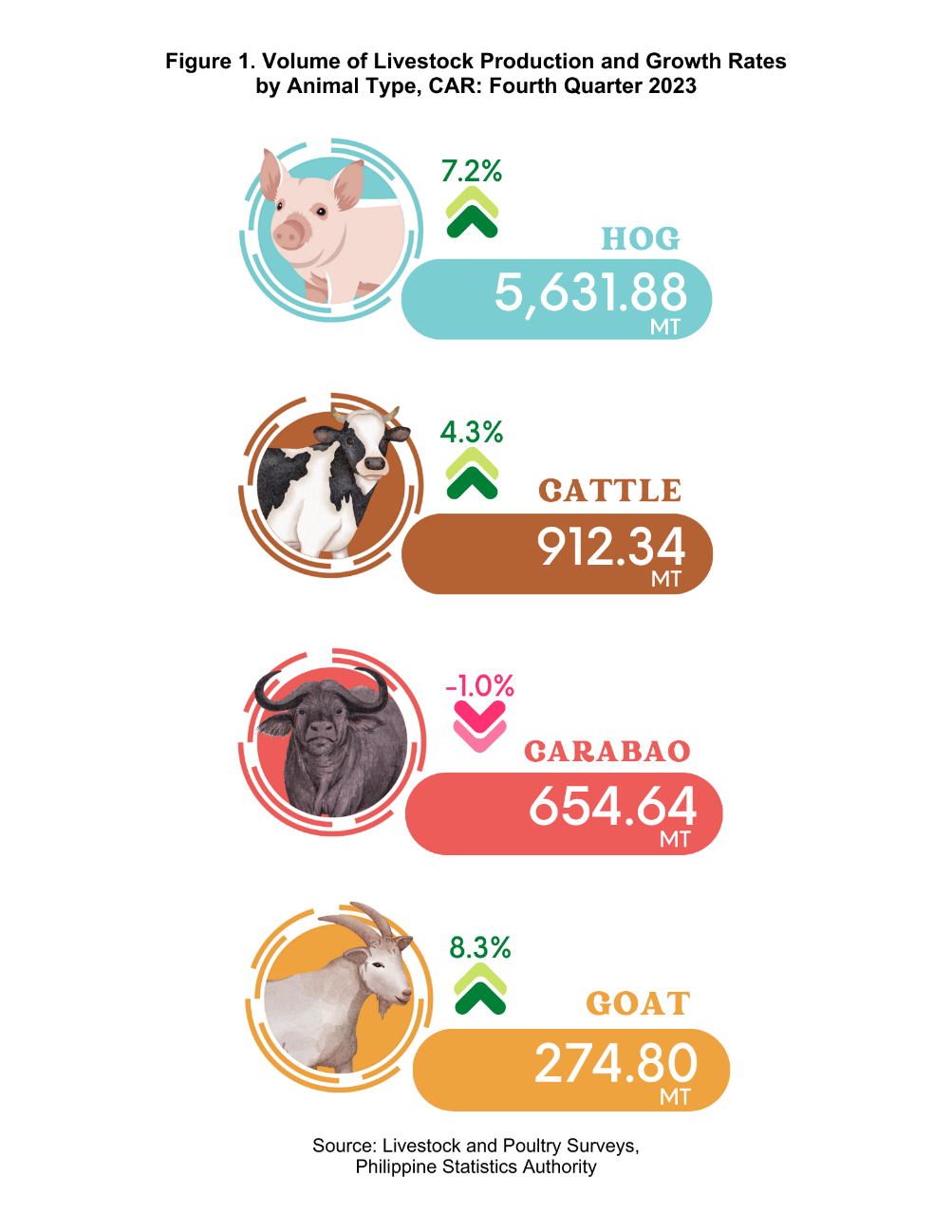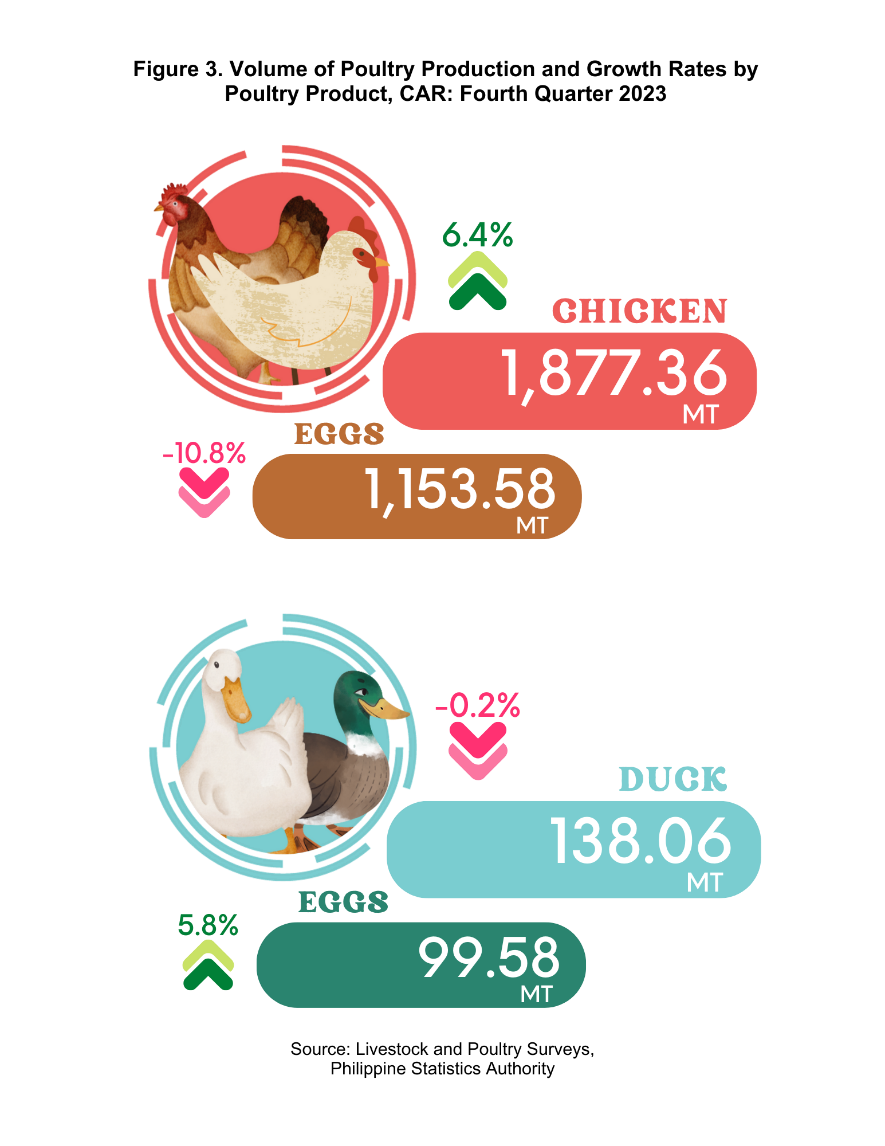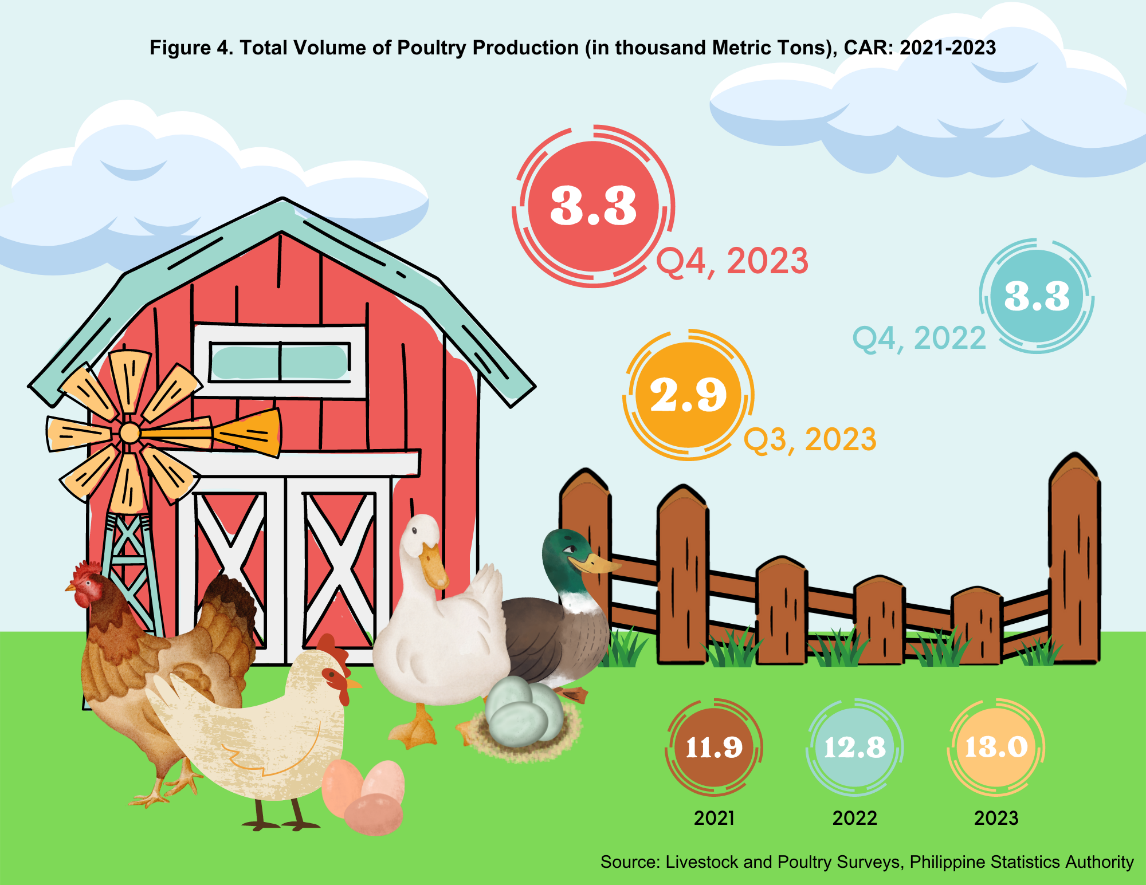The Livestock and Poultry Surveys are major agricultural surveys conducted quarterly by the Philippine Statistics Authority (PSA). The Backyard and Commercial Livestock and Poultry Surveys generate estimates on inventory, supply and disposition, and other related data of livestock and poultry commodities from households and from establishments, respectively.
 This Special Release presents the performance of the livestock and poultry sector of the region during the fourth quarter of 2023 in terms of total volume of production of livestock commodities, namely, carabao, cattle, hog, and goat; and poultry commodities that include chicken, chicken eggs, duck, and duck eggs.
This Special Release presents the performance of the livestock and poultry sector of the region during the fourth quarter of 2023 in terms of total volume of production of livestock commodities, namely, carabao, cattle, hog, and goat; and poultry commodities that include chicken, chicken eggs, duck, and duck eggs.
Hog production is main driver of livestock production growth in Q4 2023
The total volume of livestock production in the Cordillera Administrative Region (CAR) in the fourth quarter of 2023 was estimated at 7,501 metric tons. This was composed of 5,632 metric tons of hog, 912 metric tons of cattle, 655 metric tons of carabao, 275 metric tons of goat, and 27 metric tons of other livestock commodities that include sheep, rabbit, horse, and dairy products.
This translated to a 5.8% growth in the total volume of livestock production in the region in 2023. Contrarily, in terms of quarter-on-quarter comparison, the production of livestock commodities declined by 4.5% from 7,855 metric tons in the third quarter to 7,501 metric tons in the fourth.
Of the 5.8% production upturn during the quarter, hog production contributed most with 5.3 percentage points. In addition, cattle and goat production recorded 0.5 and 0.3 percentage-point contributions, respectively. Meanwhile, the production of carabao and other livestock commodities decelerated the regional production by 0.4 percentage points.
The goat sub-sector recorded an 8.3% upswing in production in the fourth quarter of 2023. This was the fastest growing sector in the livestock industry of the region during the period. Hog and cattle production also recorded growths with 7.2% and 4.3%, respectively. On the other hand, the production of carabao contracted by 1.0%. Other livestock commodities such as rabbit and dairy products also recorded declines in the fourth quarter.
In terms of share to the total volume of livestock production in CAR, hog production comprised three-fourths of the region’s total livestock output in the fourth quarter of 2023. Meanwhile, the production of cattle had a 12.2% share while carabao and goat accounted for 8.7% and 3.7% of the total CAR livestock production, respectively.

Looking at the bigger picture, the Philippines produced 616,809 metric tons of livestock commodities in the fourth quarter of 2023. Compared to other regions, CAR remained to be one of the smallest contributors to the country’s total volume of livestock production with a 1.2% share.
Figure 2 shows the total volume of livestock production of CAR across years, highlighting the third and fourth quarters of 2023 as well as the fourth quarter of 2022. The region produced about 410 metric tons more during the fourth quarter of 2023 compared to the total livestock commodities produced during the same quarter of the previous year. Conversely, the livestock production of the region in the fourth quarter of 2023 was 354 metric tons lower than the previous quarter’s recorded output.
Chicken egg production pulls poultry sector down in Q4 2023

Cordillera’s poultry sector, in terms of total volume of production, declined by 1.2% from the 3,309 metric-ton production in the fourth quarter of 2022 to the 3,270 metric tons of poultry products produced during the same quarter of the preceding year.
All poultry commodities posted declines in Q4 2023 with turkey egg production contracting the fastest with -100.0%. This was followed by turkey production with a 70.1% decline. Conversely, goose, chicken, and duck egg production grew by 147.2%, 6.4%, and 5.8%, respectively.
In terms of contribution to the total regional poultry output, chicken and chicken eggs contributed 1,877 and 1,154 metric tons, respectively. Together, these accounted for 92.7% of the total CAR poultry production. On the other hand, duck (138 metric tons) and duck eggs (100 metric tons) combined for 238 metric tons or 7.8% of the total poultry output of the region.
The production of chicken egg was the main contributor to the decline of poultry production in the region with 4.2 percentage points. Moreover, duck production further hampered regional production by 0.5 percentage points.
The total volume of poultry production of the region contributed a minimal 0.4% to the 743,724 metric-ton output of the poultry sector of the country in the fourth quarter of 2023.
Figure 4 shows that the total volume of poultry production of CAR in Q4 2023 (3.27 thousand metric tons) was higher than the recorded levels of the previous quarter (2.94 thousand metric tons) but lower than that of the same quarter of the previous year (3.31 thousand metric tons).

(SGD)
VILLAFE P. ALIBUYOG
Regional Director
AFRBJ/KAMC
Technical Notes
The data for this publication were collected by PSA through the two surveys, namely, Backyard Livestock and Poultry Survey (BLPS) and the Commercial Livestock and Poultry Survey (CLPS).
Livestock refers to farm animals kept or raised for consumption, work, or leisure. In general, poultry is separated as a distinct group of farm animals. For purposes of censuses and surveys, livestock covers only those that are tended and raised by an operator.
Livestock/Poultry Production refers to the volume of indigenous (locally-raised) animals disposed for slaughter plus animals exported or shipped-out for slaughter both in liveweight equivalent.
Poultry is a collective term for all domesticated avian for the purpose of food consumption or, the carcass of such avian dressed/processed for human consumption. Fowl is a term used to refer to a specific group of avian sharing common anatomical characteristics, e.g., chicken and turkey.

